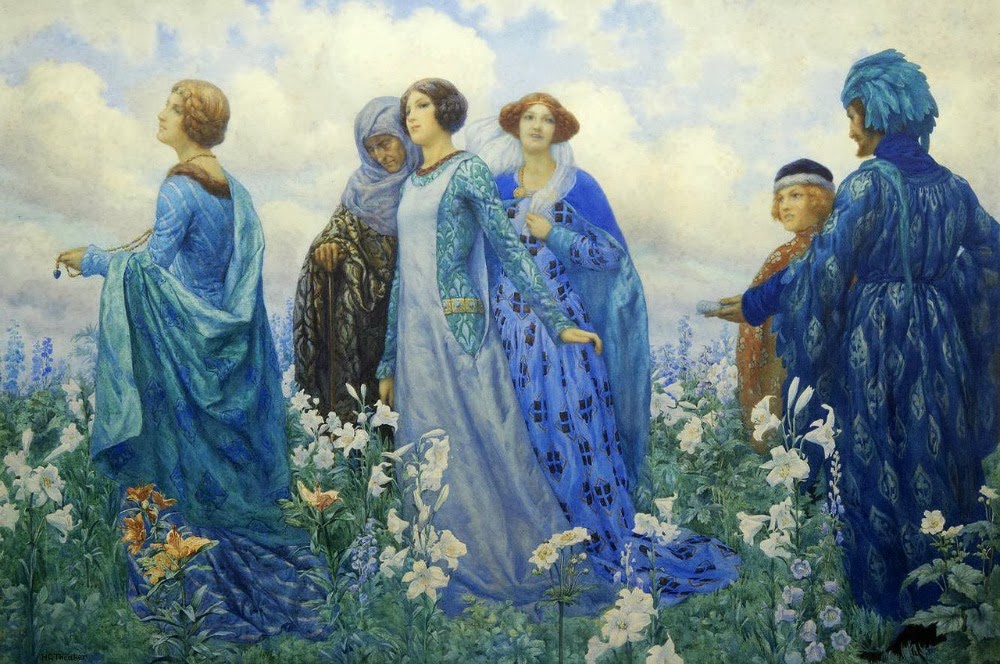Lucas CRANACH Albrecht of Hohenzollern as St. Jerome in his Study 1526
via
Lucas Maler, dit Lucas Cranach l’Ancien, né le 4 octobre 1472 à Kronach et mort le 16 octobre 1553 à Weimar, est un peintre et graveur de la Renaissance allemande. Son patronyme dérive de celui de sa ville natale. Il est le père de Lucas Cranach le Jeune (1515 - 1586).
Lucas Cranach the Elder (1472 - 1553) was a German Renaissance painter and printmaker in woodcut and engraving.
Evelyn DE MORGAN The Angel of Death c.1880
via
Evelyn De Morgan (née Evelyn Pickering le 30 août 1855 – morte à Londres en 1919) est une peintre préraphaélite anglaise.
Evelyn De Morgan (1855-1919) was an English painter whose works were influenced by the style of the Pre-Raphaelite movement. She was a follower of Pre-Raphaelist Burne-Jones. Her paintings exhibit spirituality; use of mythological, biblical, and literary themes; the role of women; light and darkness as metaphors; life and death; and allegories of war.
Gustav KLIMT The Kiss 1907-1908
via
Gustav Klimt (1862-1918) est un peintre symboliste autrichien, et l'un des membres les plus en vue du mouvement Art nouveau et de la Sécession de Vienne. Peintre de compositions à personnages, sujets allégoriques, figures, nus, portraits, paysages, dessinateur, décorateur, peintre de cartons de tapisseries, cartons de mosaïques, céramiste, lithographe.
Gustav Klimt (1862-1918) was an Austrian symbolist painter and one of the most prominent members of the Vienna Secession movement. Klimt is noted for his paintings, murals, sketches, and other objets d'art.
Arthur HACKER The Children’s Prayer 1888
via
Arthur Hacker (1858-1919) was an English classicist painter. He was born in London, the son of Edward Hacker, the line engraver. He went to the RA Schools before studying in Paris under Leon Bonnat, who was internationally famous as a portrait painter and a lifelong friend of Degas. Bonnat was the ideal teacher for Hacker who became a fashionable portrait painter himself.
His early work consisted of genre and historical scenes, such as The Waters of Babylon and The Annunciation which was brought by the Chantrey Bequest in 1892. As an indirect result of the success of this painting he was elected an associate of the RA and soon after began teaching at the Academy, when he partially abandoned subject painting in favour of portraiture, in which he achieved considerable success.
He was elected an Academician in 1910 and began to paint a series of London street scenes, including A Wet Night in Piccadilly Circus, which met with mixed reception from the critics who were not prepared for a painting of this nature, which was far more modern in its treatment that anything else Hacker had produced.
In his later years he returned to painting mythological and allegorical subjects. He died on Wednesday, 12 November 1919 in London, where he had resided all his life, and was buried at Brookwood Cemetery near Woking, Surrey.
REMBRANDT Jesus
via
Rembrandt van Rijn (en néerlandais), habituellement désigné sous son seul prénom de Rembrandt (1606/1607-1669) est généralement considéré comme l'un des plus grands peintres de l'histoire de la peinture, notamment de la peinture baroque, et l'un des plus importants peintres de l'École hollandaise du XVIIe siècle. Rembrandt a également réalisé des gravures et des dessins et est l'un des plus importants aquafortistes de l'histoire. Il a vécu pendant ce que les historiens appellent le siècle d'or néerlandais, durant lequel culture, science, commerce et influence politique des Pays-Bas ont atteint leur apogée.
Rembrandt Harmenszoon van Rijn (1606/1607-1669) was a Dutch draughtsman, painter, and printmaker. A prolific and versatile master across three media, he is generally considered one of the greatest visual artists in the history of art and the most important in Dutch art history. Unlike most Dutch Masters of the 17th century, Rembrandt's works depict a wide range of style and subject matter, from portraits, self-portraits, to landscapes, genre scenes, allegorical and historical scenes, biblical and mythological themes as well as animal studies. His contributions to art came in a period of great wealth and cultural achievement that historians call the Dutch Golden Age when Dutch Golden Age painting, although in many ways antithetical to the Baroque style that dominated Europe, was extremely prolific and innovative, and gave rise to important new genres in painting.
Subscribe to:
Posts (Atom)




+1912.jpg)










.jpg)




.jpg)
.jpg)





+Ellen+Terry.jpg)












+-+Portrait+of+Duke+Anton+of+Lotharingen.Circa+1543.jpg)








